The Changing Face of Breastfeeding in Myanmar
August 2018

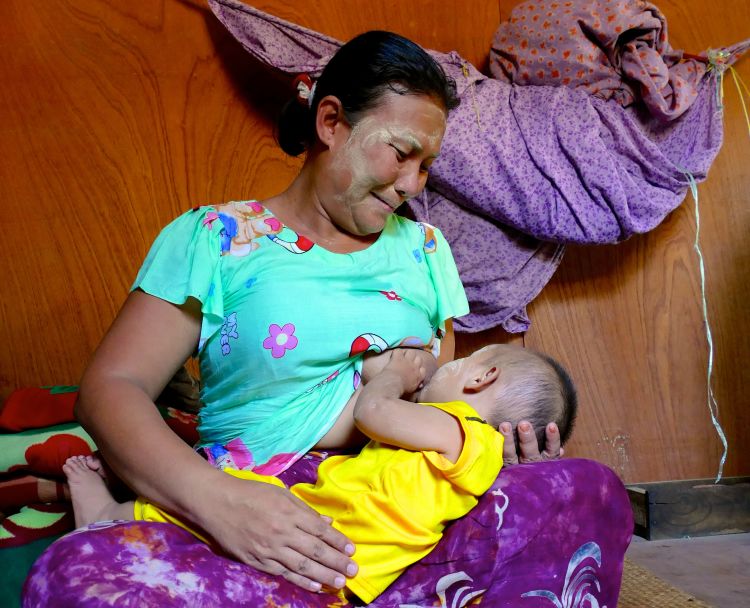
Shwe Pyi Thar, urban slum area. Aye Zar Zar Soe with her youngest son. Photo credit: Giacomo Pirozzi | Alive & Thrive.
Shwe Pyi Thar, urban slum area. Aye Zar Zar Soe with her youngest son. Photo credit: Giacomo Pirozzi | Alive & Thrive.
Breastfeeding is nearly universal in Myanmar, but only about 50% of children under six months are exclusively breastfed. While there is still much work to be done, the exclusive breastfeeding rate has more than doubled in the past 5 years.
This improvement is the result of tireless efforts and collaborations between the Myanmar Government and its partners, as well as changing attitudes and behaviors of mothers, families, and communities.
Alive & Thrive (A&T) recently met eight women who represent the new faces of breastfeeding in Myanmar.
A&T is working with the Myanmar Nurse and Midwives Association (MNMA) to further build the capacity of midwives to deliver effective counseling and support for breastfeeding.
A nurse supports Tin Tin Chit, a 30-year-old mother of two from Yangon, as she breastfeeds her newborn after giving birth the day before.
Changing provider behaviors to improve the quality and coverage of breastfeeding counseling is a priority for Myanmar, where midwives are the primary health care provider for mothers and children during the First 1,000 Days.
Breastfeeding is not a one-woman job. Fathers, elders, and other secondary caregivers play a key role in supporting mothers. Maung Hla Myint brings his older daughter to meet her new baby brother.
Tin Tin says her husband is very supportive of breastfeeding. Messages about breastfeeding and maternal and child nutrition are increasingly being targeted to families and community members in Myanmar.
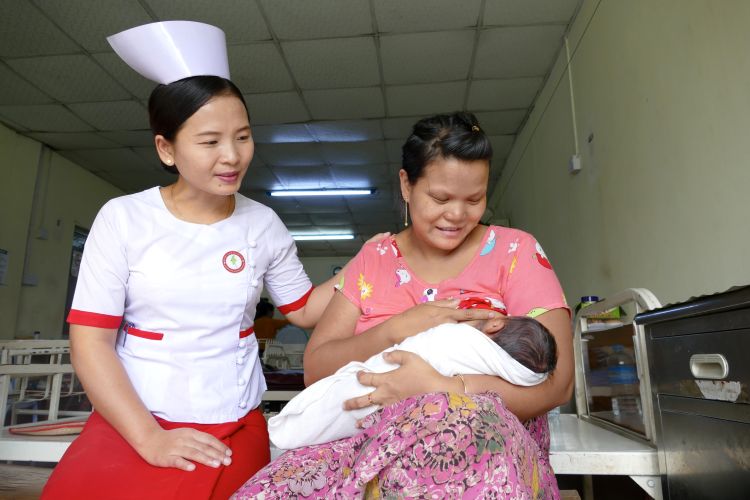
Yangon Maternity ward. Nurse assists Tin Tin Chit while she breastfeeds her newborn baby boy. Photo credit: Giacomo Pirozzi | Alive & Thrive.
Yangon Maternity ward. Nurse assists Tin Tin Chit while she breastfeeds her newborn baby boy. Photo credit: Giacomo Pirozzi | Alive & Thrive.
Htet Htet Thi and her husband Nay Myo Htun both work at telecom companies and their first child is almost 3 months old.
In accordance with the law on maternity leave for the private sector, Htet Htet was entitled to 6 weeks leave prior to delivery and only 8 weeks after.
She is now back at work and doesn’t have a space to pump. She expresses milk twice a day in the bathroom, keeping the milk in a cooler until she can get home to her freezer.
Htet Htet has been back at work only a couple of weeks and has accumulated a good amount of frozen milk.
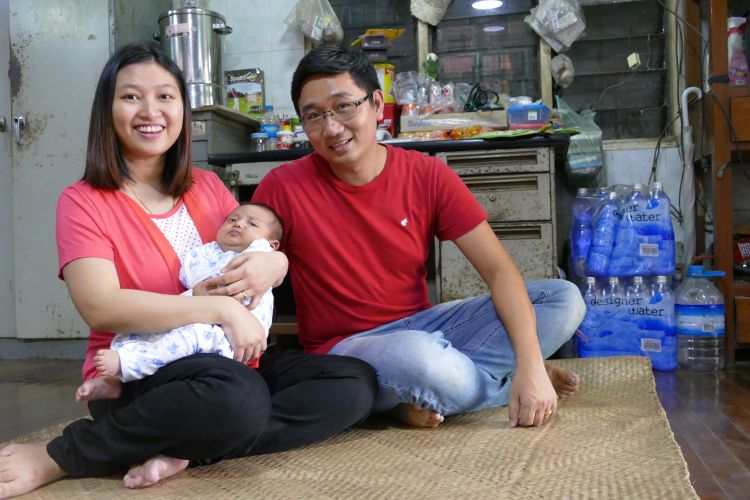
Yangon, the capital. Nay Myo Htun with his wife Htet Htet Thi and their baby. Photo credit: Giacomo Pirozzi | Alive & Thrive.
Yangon, the capital. Nay Myo Htun with his wife Htet Htet Thi and their baby. Photo credit: Giacomo Pirozzi | Alive & Thrive.
Social protection strategies like maternal child cash transfers are helping families in Myanmar to improve nutrition practices during the First 1,000 Days. In Shwe Pyi Thar, a peri-urban slum community in Yangon, Lwin Mar Kyew and her family are benefiting from a cash transfer program being implemented by Save the Children.
With her oldest child (now 7 years old), she had a restricted diet due to food taboos during and after her pregnancy. More recently, with her youngest, she has not abided by the same restrictions and feels stronger and healthier.
She has been pressured by her aunties to feed him water in the hot weather but knows that breastmilk is the only food he needs until 6 months.
For another mother in Shwe Pyi Thar, circumstances are very different with her 10-month- old, who is the youngest of her 6 children.
Previously, Aye Zer Zersoe had to return to work in the informal sector as soon as possible. But now, monthly cash transfers provided by Save the Children in collaboration with other partners provides just enough for her to afford healthy food, and to not have to leave him to go back to work just yet.
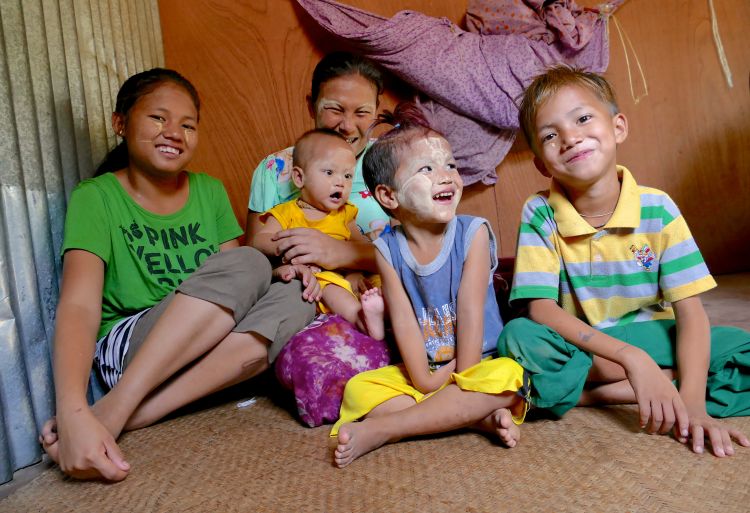
Shwe Pyi Thar, urban slum area. Aye Zar Zar Soe at home with 4 of her 6 children. Photo credit: Giacomo Pirozzi | Alive & Thrive.
Shwe Pyi Thar, urban slum area. Aye Zar Zar Soe at home with 4 of her 6 children. Photo credit: Giacomo Pirozzi | Alive & Thrive.
These two sisters have very different breastfeeding experiences. Theint Theint Win (left) works as a cleaner and left her job before the birth of her second child to be able to exclusively breastfeed.
Her sister, Hnin Yu Yu Swe, could only take one month off from her job as a freelance tutor following the birth of her daughter. She felt she had to supplement breastmilk with formula milk when she returned to work, yet she wants to continue breastfeeding as long as she can.
San San Myint has three kids and owns her own party décor business. Her oldest is 12 years old and her youngest is 15 months. Her experience was very different with each of her 3 children and although she prefers to breastfeed she has been influenced by her friends and community to start using formula. Many in her social circles say, “If you drink [formula], you will be tall.”
Her youngest has tried formula but prefers breastmilk and feeding him at her breast makes her happy.
She also suffers from diabetes and knows that breastfeeding is beneficial for both herself and her child, so she plans to continue “for as long as he wants.”
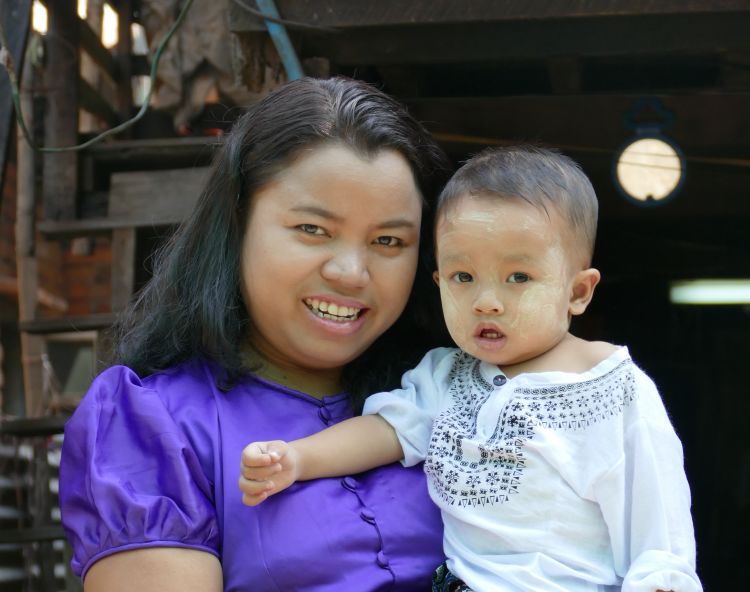
Yazkin a suburb of Yangon. San San Myint holds her younger son just outside her home. Photo credit: Giacomo Pirozzi | Alive & Thrive.
Yazkin a suburb of Yangon. San San Myint holds her younger son just outside her home. Photo credit: Giacomo Pirozzi | Alive & Thrive.

Akayi Zin Ten and her husband had concerns their daughter Dora was not growing fast enough. She began searching for advice about breastfeeding and starting complementary foods and found Thelma Tun Thein, a nutritionist and International Board-Certified Lactation Consultant (IBCLC), through a Facebook group for moms.
Thelma eased their fears and showed them how to introduce complementary foods in addition to continuing breastfeeding. Thelma has a unique skillset in Myanmar and has become a sought-after source of advice for new mothers and health workers facing challenges related to infant and young child feeding (IYCF).
Alive & Thrive is funded by the Bill & Melinda Gates Foundation and the governments of Canada and Ireland and is managed by FHI 360.

